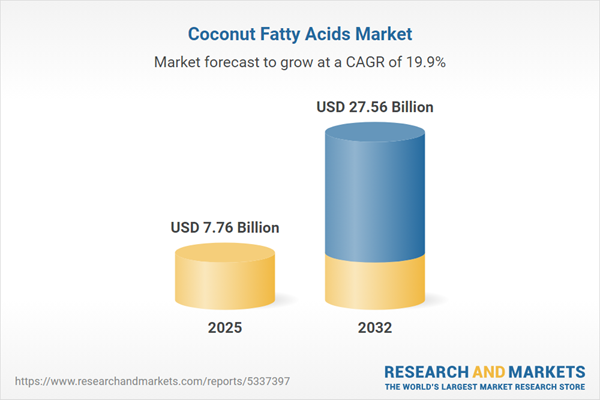Speak directly to the analyst to clarify any post sales queries you may have.
Senior decision-makers are positioning coconut fatty acids at the center of their procurement strategies to ensure supply chain security and support ongoing sustainability objectives. As industry regulations evolve and stakeholder expectations heighten, the ability to rapidly adapt procurement processes around coconut fatty acids is increasingly vital for organizational resilience and growth.
Market Snapshot: Coconut Fatty Acids Trend Analysis and Growth Outlook
The global coconut fatty acids market demonstrates strong momentum, driven by increased demand for sustainable, bio-based inputs and a marked shift toward flexible sourcing. Senior procurement executives are responding to dynamic trade environments and accelerated regulatory transformation by evolving their supplier networks to secure continuous operations. This heightened emphasis on agility is reflected across major buyer industries, including personal care, food and nutrition, manufacturing, and pharmaceuticals, where supply continuity and compliance drive procurement priorities. The sector’s expansion is further fueled by the adoption of sustainable alternatives and the diversification of global sourcing models, helping firms unlock new revenue streams while managing exposure to supply risks.
Coconut Fatty Acids Market Scope & Strategic Segmentation
A comprehensive understanding of coconut fatty acids market segmentation is crucial for procurement leaders aiming to anticipate change, mitigate risk, and enhance supplier relationships. Each key segment aligns with strategic organizational priorities, supporting robust growth and controlled exposure to external disruptions.
- Product Types: Capric Acid, Caprylic Acid, Lauric Acid, and Myristic Acid offer unique chemical profiles, supporting specialized applications in both developed and emerging markets.
- End Use Industries: Animal feed, personal care, cosmetics, pharmaceuticals, food processing, and manufacturing rely on coconut fatty acids to achieve consistent product quality and ensure stable supply throughout production phases.
- Distribution Channels: Offline distributors, wholesalers, as well as specialized digital procurement platforms, expand sourcing flexibility and integrate diverse supplier bases to maintain operational consistency.
- Key Regions: The Americas, Europe, Middle East & Africa, and Asia-Pacific each present unique sourcing challenges, regulatory standards, and opportunities, requiring tailored approaches to risk assessment and strategic market entry.
- Technologies & Sourcing Approaches: Sustainable materials, advanced extraction methods, bioscience technologies, digital traceability, and compliance automation contribute to improved reliability, streamlined auditing, and rapid adaptation to regulation changes.
Coconut Fatty Acids: Key Takeaways for Senior Stakeholders
- Sustainable procurement strategies are vital to enhance organizational agility and prepare for fast-changing trade and regulatory environments.
- Utilizing bio-based ingredients improves traceability, aids in meeting sustainability standards, and supports ethical sourcing initiatives.
- Integrating digitized procurement and supplier management systems increases transparency, ensures regulatory alignment, and enhances responsiveness across complex, multi-regional supply networks.
- Adoption of traceability technology—including modular processing and distributed ledger tools—fortifies supplier trust and supports consistent quality assurance.
- Market strategies customized to regional sourcing environments open access to new markets and strengthen collaborations with local suppliers.
- Active engagement with suppliers nurtures operational stability while fostering innovation and flexible procurement models that align with evolving business needs.
Tariff Impact: United States 2025 Import Measures
Anticipated tariffs on coconut-based ingredients in the United States require immediate assessment of supplier partnerships and sourcing arrangements. Senior executives are proactively identifying alternative regional suppliers and evaluating increased domestic processing to maintain regulatory compliance. These strategic responses are being leveraged to minimize operational disruptions, ensuring business continuity and protecting profitability amid shifting trade policies.
Methodology & Data Sources
This report is informed by a combination of executive surveys, expert interviews, and consultations with experienced procurement professionals. All insights have been validated against current regulatory documents and recent academic research to ensure accuracy for coconut fatty acids buyers and specialists.
Why This Report Matters
- Equips procurement leaders with actionable segmentation and risk assessment to support resilient sourcing strategies as sustainability and compliance needs advance.
- Delivers expert guidance to help unlock supply chain efficiencies, encouraging responsible supplier partnerships and proactive risk management in key markets.
- Enables informed decision-making for integrating digital procurement and sustainable sourcing approaches that align with evolving industry demands.
Conclusion
Strategically sourcing coconut fatty acids empowers organizations to address supply chain uncertainties, strengthen regulatory alignment, and position confidently for sustainable long-term growth.
Additional Product Information:
- Purchase of this report includes 1 year online access with quarterly updates.
- This report can be updated on request. Please contact our Customer Experience team using the Ask a Question widget on our website.
Table of Contents
3. Executive Summary
4. Market Overview
7. Cumulative Impact of Artificial Intelligence 2025
Companies Mentioned
The companies profiled in this Coconut Fatty Acids market report include:- KLK Oleo Sdn Bhd
- Wilmar International Limited
- Cargill, Incorporated
- Emery Oleochemicals LLC
- AAK AB
- IOI Oleochemical Sdn Bhd
- Musim Mas Holdings Pte. Ltd.
- BASF SE
- Croda International Plc
- VVF Loders Croklaan India Private Limited
Table Information
| Report Attribute | Details |
|---|---|
| No. of Pages | 199 |
| Published | October 2025 |
| Forecast Period | 2025 - 2032 |
| Estimated Market Value ( USD | $ 7.76 Billion |
| Forecasted Market Value ( USD | $ 27.56 Billion |
| Compound Annual Growth Rate | 19.8% |
| Regions Covered | Global |
| No. of Companies Mentioned | 11 |









